This all started pretty innocuously. I just wanted a client to have a warm floor. How complicated could that be? Well some seemingly innocuous code language made things irritating but not difficult and I sucked it up. But then the LEED fascists made things difficult and unworkable and finally I said enough is enough. It is time for the old guy to strike back.2
When you have a bedroom over garage in a cold climate builders typically get complaints of cold floors. What a surprise.3 It is easy to construct a warm floor. The best way to do it is shown in Figure 1. Continuous rigid insulation is used across the underside of the floor framing. Notice the air space above the cavity insulation. That airspace makes the floor warmer than if the cavity was completely filled as shown in Figure 2. Huh?4 Yes, the airspace makes for a warmer floor. Filling the airspace completely reduces heat flow and saves energy but does not make the floor warmer. Old guys taught us this.
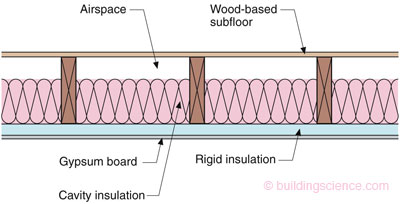
Figure 1: Hot Stuff – Best way to construct a warm floor. Continuous rigid insulation coupled with an airspace above cavity insulation.
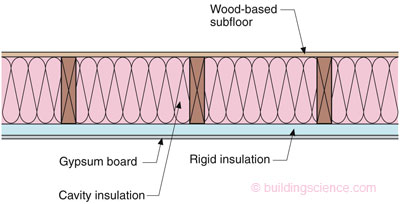
Figure 2: Efficient Stuff - Not as warm but energy efficient. Filling the airspace reduces heat transfer but the floor is colder.
Remember back in the 60’s when we had ghosting on steel framing in commercial buildings? The ghosting was due to Brownian motion. We quickly learned that installing insulation according to Figure 3 made the interior surface of the studs warmer than if the insulation was installed as in Figure 4. Warmer interior stud surface temperature made the ghosting go away. Think 2-D heat flow and have a beer and it will make sense to you. Or play with THERM. Trust me the beer approach is better. Anyway, understanding this explains why the airspace on the top of the insulation in Figure 1 makes the floor warmer.
So what is the problem? We knew how to do this since I was a young guy in the Great White North. Life was good. Floors were warm and the beer was cold. Then I fell in love. Moved south. It happens. Apparently how to have warm floors over garages is not well understood outside of Minnesota in the Land of the Free and the Home of the Brave.
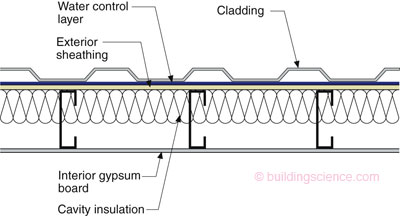
Figure 3: No Ghosting – Think 2-dimensional heat flow. Interior face of the steel stud is warmer with the cavity insulation aligning with the sheathing leaving an airspace to the interior. The warmer stud surface reduces thermal deposition or ghosting.
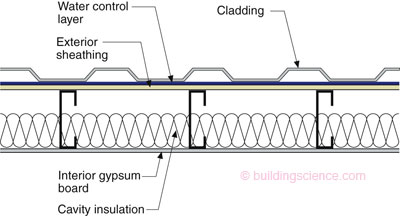
Figure 4: Ghosting – Cold stud interior surface leads to ghosting. Give me an airspace to the interior, or better still, give me continuous exterior insulation.
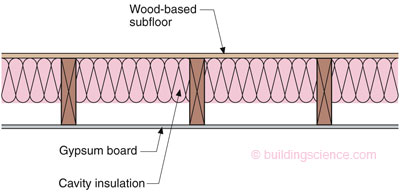
Figure 5: Code Compliant and Cold – “IECC: 402.6 Floors. Floor insulation shall be installed to maintain permanent contact with the underside of the subfloor decking.”
The code is the first problem. The code states that I must install the insulation in direct contact with the underside of the floor as in Figure 5. The exact wording from the IECC: “402.6 Floors. Floor insulation shall be installed to maintain permanent contact with the underside of the subfloor decking.” Fortunately, most building officials are not morons. In fact many of them are very smart. You can actually talk to them. Good luck with LEED raters. We will get into that shortly. I am working on a code change for the next round. I do not see a problem there. Except, timing wise the soonest documents that folks can reference will be the IECC 2015 and the IRC 2015. In the meanwhile be nice to your code official as they can use judgment to interpret things. And judgment they do have. No committees to deal with. Local is nice.
Judgment is not allowed with LEED. I have no trouble with the code folks as they have judgment - so doing it “right” is not a code violation. Different story with LEED. Does not matter what the code official says. The LEED folks should take to wearing nice brown shirts. Have to go with Figure 2 when LEED is involved unless you do a “work around.” Here is the work around. EPA ENERGY STAR says that you must “align the thermal barrier with the air barrier.” LEED says you have to follow ENERGY STAR and so we have an opening for a “work around.” Just call the rigid insulation the air barrier and we are good to go. Never mind that the air barrier is the subfloor. But you can “fake it” sufficiently to make it fly. You can argue that rigid insulation with joints taped can act as an air barrier. And you point out that you air seal and insulate the perimeter so you create a “bathtub” lined with insulation (Figure 6). Bobby Darin here we come. I am not happy having to do it this way. Feels pretty sleazy to me - having to ignore physics to answer to a bureaucratic Borg. But resistance is futile so I suck it up and deal with it.

Figure 6: Bathtub - Air seal and insulate the perimeter so you create a “bathtub” lined with insulation.
Then it finally gets too much. A seemingly minor thing that a normal person should laugh off gets blood shooting out of my eyes. Podium construction5 with wood frame on top finally got to me (Figure 7). A pretty benign way to construct this detail is shown in Figure 8. Works great. Told by one of the Brownshirts that I can’t use it.
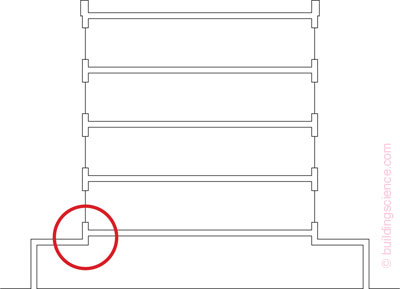
Figure 7: Podium Construction – Wood frame is typically constructed over the top of a concrete podium, hence the name. Insulating the underside of the concrete podium at the perimeter of the conditioned “footprint” is a big deal. The “red” circle is “red” because bad things can happen there.
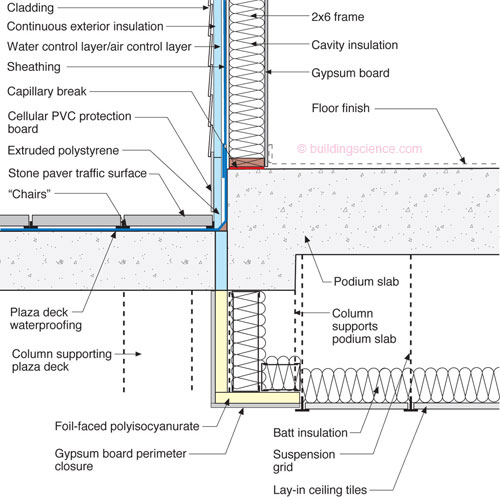
Figure 8: Inside the Red Circle – Works great but violates LEED because it violates EPA ENERGY STAR. The thermal barrier does not align itself with the air barrier. There is no way the “work around” works here. No way that you can make the argument that a lay-in ceiling tile suspended ceiling is an “air barrier.” The concrete slab is the air barrier for sure.
Figure 8 violates LEED because it violates EPA ENERGY STAR. The thermal barrier does not align itself with the air barrier. There is no way the “work around” works here. No way that you can make the argument that a lay-in ceiling tile suspended ceiling is an “air barrier.” The concrete slab is the air barrier for sure.
So here we go. Time to fix things permanently. Have to fix ENERGY STAR. The “must align the thermal barrier with the air barrier” rule always bothered me because there is no physics justification for it but it never bothered me enough to take a run at it – until now. The rule didn’t come from ASHRAE. No peer-reviewed papers cite it in the literature. Where did it come from? It just sort of magically showed up in the early 90’s.6
What was the underlying issue that the rule attempts to address? The answer to that question is easy: air leakage through, around and within air porous insulation. If you do not have air leakage through, around and within porous insulation you don’t need to align anything with anything. The keys to understanding this issue are air pressure differences and insulation density. As air pressure differences drop the effect of airflow on the thermal performance of insulation also drops. Duh. As insulation density goes up resistance to airflow goes up and therefore the effect of airflow on the thermal performance of insulation also drops. Duh.
Let’s examine two bathtubs both filled with insulation – an “attic” bathtub and a “crawlspace” bathtub (Figure 9). From a code perspective and an EPA ENERGY STAR/LEED perspective we are all “tickety boo.”7 Air can’t get into the insulation from the sides or through the bottom in an attic due to the bottom of the bathtub and the sides of the bathtub or through the top or sides when the bathtub is inverted in the crawlspace case.
One issue to deal with is air blowing into the bathtub from the top or bottom respectively (Figure 10). This is not typically an issue due to the absence of wind in attics and crawlspaces and due to the density of the “fluffy stuff.” Yes, attics and crawlspaces are vented and there is airflow but they are sheltered from the wind. Get a grip here folks. Note that we are talking about assemblies sheltered from the wind – attics and crawlspaces and garages. Assemblies where air cannot enter at perimeters. I remind everyone again that the sides of the bathtub are sealed. We are not talking about a cantilevered floor exposed to the wind with a perforated vented soffit.
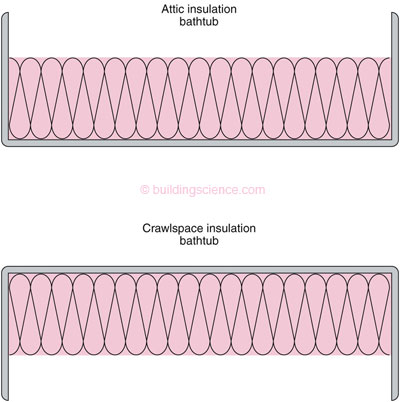
Figure 9: Two Bathtubs - An “attic” bathtub and a “crawlspace” bathtub. We are code compliant and EPA ENERGY STAR/LEED compliant. Air can’t get into the insulation from the sides or through the bottom in an attic due to the bottom of the bathtub or through the top when the bathtub is inverted in the crawlspace case.
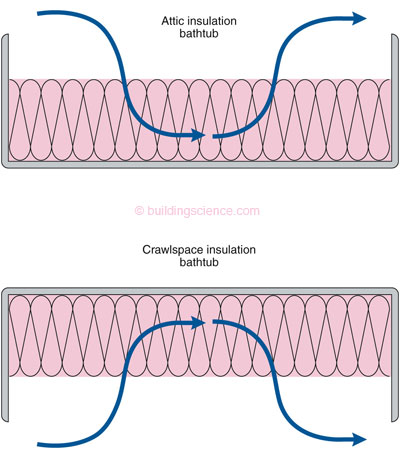
Figure 10: Wind - Air blowing into the bathtub from the top or bottom respectively is not typically an issue due to the absence of wind in attics and crawlspaces and due to the density of the “fluffy stuff.” Yes, attics and crawlspaces are vented and there is airflow but they are sheltered from the wind. Get a grip here folks. Note that we are talking about assemblies sheltered from the wind – attics and crawlspaces and garages. Assemblies where air cannot enter at perimeters. I remind everyone again that the sides of the bathtub are sealed. We are not talking about a cantilevered floor exposed to the wind with a perforated vented soffit.
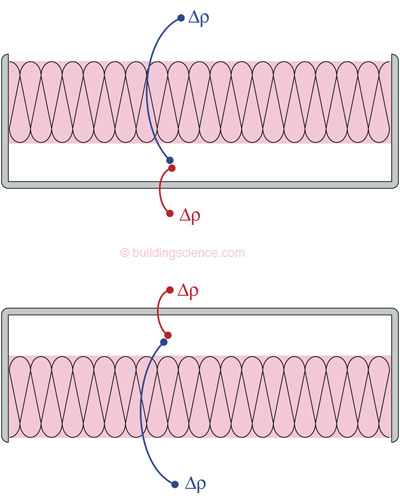
Figure 11: Airspace – Not a lot happens when there is an airspace between the insulation and the bottom or top of the top respectively because there is for all practical purposes no air pressure difference across the insulation – the “blue” delta P. This is not a wall. No stack effect. No real convection. The big pressure difference is the “red” delta P.
So what happens when there is an airspace between the insulation and the bottom or top of the top respectively (Figure 11)? Not a heck of a lot because there is for all practical purposes no air pressure difference across the insulation. This is not a wall. No stack effect. No real convection. You could get some convection in ceiling insulation or floor insulation if there is a huge temperature difference and the insulation is of real low density. But let me remind you once again there is a big difference between a wall and a ceiling or floor because the stack pressure depends not only on the temperature difference but also on the height of the cavity (Figure 12). Wall tall. Floor short. Ceiling short. Lie the wall down and the stack effect goes away.
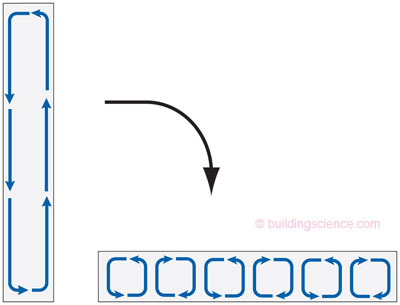
Figure 12: Wall vs. Ceiling/Floor - There is a big difference between a wall and a ceiling or floor because the stack pressure depends not only on the temperature difference but also on the height of the cavity. Wall tall. Ceiling and floor short. Lie the wall down and the stack effect goes away.
You still have to worry about air blowing into the stuff from the top or bottom (Figure 13). But this issue is not made worse in any practical sense with the airspace. It is the same problem as in Figure 10 alignment or not. The flow path resistance in Figure 13 can be increased significantly if the fluffy stuff is batt insulation that is faced on one side such as kraft faced batt insulation.
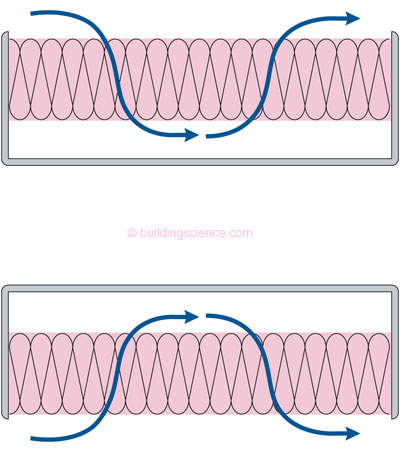
Figure 13: Wind Redux - You still have to worry about air blowing into the stuff from the top or bottom. But this issue is not made worse in any practical sense with the airspace. It is the same problem as in Figure 10 alignment or not. The flow path resistance can be increased significantly if the fluffy stuff is batt insulation that is faced on one side such as kraft-faced batt insulation.
So that takes me to the final bathtub in Figure 14 – which is really Figure 8 in disguise – a bathtub with holes in the bottom of it lined with insulation. If I keep the wind out of the fluffy stuff at the sides and edges I don’t need to align it with the air barrier. As I mentioned earlier it gets even better if the fluffy stuff is a faced batt.

Figure 14: Rub-a-Dub Tub - Figure 8 in disguise - bathtub with holes in the bottom of it lined with insulation. If I keep the wind out of the fluffy stuff at the sides and edges I don’t need to align it with the air barrier.
So why is all this such a big deal? In Figure 8 if I have to move the insulation from the top of the lay-in tiles to the underside of the concrete deck I have to use stick pins and it costs my client an extra $100K on this job. It is a big job. And it makes my floor colder and does not save any energy. And for what? To get a LEED rating. I call it a LEED tax. There are far better places to spend $100K. The best is not to spend it at all. And if you were to spend it for energy or other green things the money could easily be spent better. All this does is lose credibility for LEED and ENERGY STAR. We can fix this. Just a simple change from EPA ENERGY STAR saying I don’t need to align the thermal barrier with the air barrier in floor assemblies and ceiling assemblies as long as I keep the sides of the bathtub intact and I am protected from the wind. What say you ENERGY STAR? I got the code thing covered.
I will deal with the alignment thing for walls some other time. You don’t need to do it there either but the situation is much more complicated because of wind effects, stack effects and enclosure air leakage. Later.
Footnotes:
One of my all time favorite guys is Bobby Darin whose first hit song was “Splish Splash”…taking a bath. The bathtub connection to this column and hence to Bobby Darin will become obvious. Legend is that he died of a broken heart – he should have married Connie Francis rather than Sandra Dee. He never recovered from heart surgery and died in the recovery room Christmas 1973. At the time I was on a beach in Florida, a mixed up teenager with his own problems of the heart. As a child Darin suffered from rheumatic fever that resulted in a weak heart and that is what is cited as the official reason for his death. But I believe the legend - a broken heart sometimes never heals – at least that is what I thought when I was a teenager.
OK, I am not striking back, I am whining. But I have it on good authority that whining is a form of therapy. Apparently lots of folks I know are in this process of therapy.
Notice no question mark on this sentence. It is a statement, not a question. It is a rhetorical device, a literary technique.
This is engineering terminology. “Huh” denotes a legitimate question. “Huh” is not to be confused with “Duh” which is a legitimate answer. This is slightly different than “D’oh” which is often associated with the pain arising from hitting your head against a solid object. For engineers, Duh typically follows D’oh preceded by Huh. For more details on this consult Homer Simpson. Huh-doh-duh is referred to as the engineering method. Huh is often quickly followed by Duh when engineering beverages are involved. The D’oh comes in the morning.
We covered this in detail in “BSI-059: Slab Happy"
Actually I know exactly where it came from. It came from the legendary and charismatic John Tooley who used it as a teaching tool for homebuilders and insulation contractors. Subsequently, it was picked up by the equally legendary and charismatic Sam Rashkin and it found its way into ENERGY STAR. John never intended it to end up as an inviolate rule – something that is sacred and must be protected – an ancient permanence – from the 90’s. Apologies to Thomas Hardy. Building science is fast becoming a cult with religious overtones with a blower door as its scepter where orthodoxy cannot be questioned. If we are not careful it could become LEED.
Canadian expression meaning “OK.” Canadians picked it up from the Brits in the RAF when Canucks were on the other side of the pond fighting the Hun. The Brits brought it from India. According to Michael Quinion the British Army in India used the Hindi phrase “thik hai babu” which means “it’s alright, sir” (www.worldwidewords.org/qa/qa-tic1.htm).
